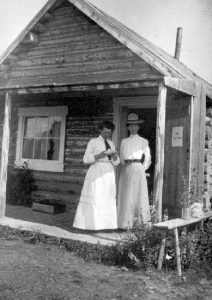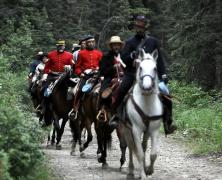 I have always subscribed to the theory that the American west was the stuff of gunslingers and range wars, while the Canadian west was orderly, hard-working and a bit dull.
I have always subscribed to the theory that the American west was the stuff of gunslingers and range wars, while the Canadian west was orderly, hard-working and a bit dull.
My latest reading has shaken that idea into the gumbo of Saskatchewan mud. Red Lights on the Prairies by James Grey is a study of the “social evil,” in Canada’s prairie provinces from the late 1880’s until the end of WWII.
James Grey, a son of the prairies, had a successful career as a newspaper man before retiring and turning his hand to writing books. His work is littered with references to various newspapers of the period, along with police reports and first hand accounts from old timers. The result is an entertaining and readable history of Canada’s west that never appeared in my social studies classes in school.
He begins his account in Winnipeg, the first of the prairies cities to achieve city status. The development of this city was mimicked in large part by other centres like Regina, Calgary, Edmonton and Saskatoon. The railway arrived first and the town grew around the station. The town-sites had virtually no infrastructure so hotels, shops, livery stables and houses were thrown up willy-nilly in close proximity to the station. Travellers getting off the trains were met with an abundance of bars and con men, and a dearth of lodgings.
Since the vast majority of new arrivals were single men, prostitution was not only tolerated but regarded as necessary. The prevailing attitude was that with 200,000 men without female partners, brothels were just another business. Politicians and police tended to turn a blind eye to the madams and their girls provided they kept the noise and brawling to a respectable level. They were more inclined to take action against the houses-of-ill-repute on liquor offences than on moral grounds.
In all the cities of the prairie provinces, the argument around brothels centred on the question of segregation. Some notable police chiefs left the prostitutes alone so long as they stayed in their own area of town, Annabella Street in Winnipeg, River Street in Regina and Nose Creek in Calgary. When the “ladies” paraded around town in their finery, insulting the sensibilities of decent women and reforming clergy, the police were wont to “run them out of town.” The latter was a fruitless exercise as the women simply re-established their houses beyond the city borders but near enough for the cowhands, miners, railway workers, and farmers sons to find them on payday.
When the reformers and Temperance workers were able to persuade a city to close down a red light district*, the police would reluctantly comply, knowing full well the prostitutes might set up shop in the downtown district or in a back room of a hotel and the “social evil” would continue unabated. Some time later, the protests over public morals would come full circle and the women would be moved into a segregated area where they were less apt to come into contact with respectable women.
In some cities the brothels were treated like community centres. They were usually larger and more luxurious than the hotels. Town council might meet in the living room of a friendly madam. Fraternal organizations would enjoy a good dinner and music in a bordello during their monthly meeting.
It wasn’t unusual for one of the girls to grow tired of life in the brothel and marry one of her customers. The stigma attached to prostitution in our day was remarkably absent in the early 20th century. Mind you, the wife of a miner or other labourer could be a misery–a tiny shack, limited means, and hard physical labour. If the husband drank his wages the new wife might drift back to her former profession just to keep herself fed.
Back to my original perceptions — it is true that the Canadian west was less lawless than its American counterpart. The Mounties preceded the settlers in Canada. In the US settlement often came first and law and order came later. But the notion that the vast expanse of the Canadian prairie was peopled by, as Grey puts it “monks, eunuchs, and vestal virgins” has been completely overturned. Booze, broads and brawls were as much a part of settlement in Canada’s west as sod shanties and one room schoolhouses.
*There were no actual red lights in the brothels on the Canadian prairies. The term is an Americanism, no doubt imported along with the thousands of American settlers who flowed north to Canada.
Visits: 158

 This is a photo of Mrs. Friend of Atlin. B.C. taken near the turn of the twentieth century. High necked blouses and flared skirts were the order of the day. Note the detail in the lace of the blouse shown on the right, and the decoration on the skirt on the left. There is an almost “mannish” appearance to these two women, but the feminine touches are there if you look.
This is a photo of Mrs. Friend of Atlin. B.C. taken near the turn of the twentieth century. High necked blouses and flared skirts were the order of the day. Note the detail in the lace of the blouse shown on the right, and the decoration on the skirt on the left. There is an almost “mannish” appearance to these two women, but the feminine touches are there if you look.

 This one of Windimere Pioneers is dated 1890. I find it useful because Windimere is off the beaten track – not a leader in ladies fashions. Still, the women are well-dressed and out numbered. When writing of this era in the interior of British Columbia it is well to remember that men grossly out-numbered women. If a girl had a yen to marry, she’d not be short of proposals if she headed for the hinterland.
This one of Windimere Pioneers is dated 1890. I find it useful because Windimere is off the beaten track – not a leader in ladies fashions. Still, the women are well-dressed and out numbered. When writing of this era in the interior of British Columbia it is well to remember that men grossly out-numbered women. If a girl had a yen to marry, she’d not be short of proposals if she headed for the hinterland.
 Still laced tightly at the waist, but those puffed sleeves would allow for a little more movement than the narrow ones of a few years previously.
Still laced tightly at the waist, but those puffed sleeves would allow for a little more movement than the narrow ones of a few years previously. Writing historical fiction requires lots and lots of research. Since I love history, research is actually a treat and not a chore. However, writing about the Canadian West in the nineteenth century presents some unique challenges. If I do research under “Victorian,” I’ll get lots of references to Victorian England. If I try “Western” I’ll get reams of information on the American West. Thanks to Hollywood, most people perceive “Western” from the American perspective, i.e. lawlessness, range wars, famous outlaws, dangerous Indians. Those qualities make great fiction, but they do not hold true for the Canadian west. Oh, we had our share of criminals, but the westward expansion of white settlement in this country followed a different pattern that our southern neighbours. In Canada, the law and government, preceded the settlers.
Writing historical fiction requires lots and lots of research. Since I love history, research is actually a treat and not a chore. However, writing about the Canadian West in the nineteenth century presents some unique challenges. If I do research under “Victorian,” I’ll get lots of references to Victorian England. If I try “Western” I’ll get reams of information on the American West. Thanks to Hollywood, most people perceive “Western” from the American perspective, i.e. lawlessness, range wars, famous outlaws, dangerous Indians. Those qualities make great fiction, but they do not hold true for the Canadian west. Oh, we had our share of criminals, but the westward expansion of white settlement in this country followed a different pattern that our southern neighbours. In Canada, the law and government, preceded the settlers.

Recent Comments